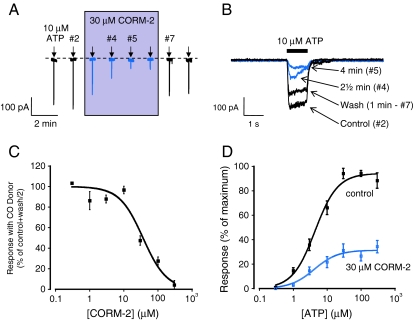Fig. 1.
CORM-2 inhibits human P2X4 currents in perforated-patch configuration. a Typical time course of currents evoked by repeated applications of ATP (10 μM, 2 s) at 90-s intervals, as indicated by the arrows. CORM-2 (30 μM) was applied for 1 min prior to second application of ATP and continuously perfused until 30 s after the sixth application, as shown by the shaded box. b Superimposed currents shown of a fast time-base taken from the record shown in a, highlighting the effect of 2.5- and 4-min 30 μM CORM-2 applications and the recovery following 1 min wash out. c Concentration–inhibition curve for CORM-2 inhibition of human P2X4 responses. Data shown are mean ± s.e.m. CORM-2 was applied for 2.5 min, and inhibition was expressed as a percentage of the average of the control and wash responses. The Hill equation was used to calculate an apparent IC50 (n = 4–8). d Mean ± s.e.m., paired ATP concentration–response curves in the presence and absence of 30 μM CORM-2. The responses from each individual cell were normalised such that the largest current observed in the absence of CORM-2 was considered to be 100% (n = 5)

